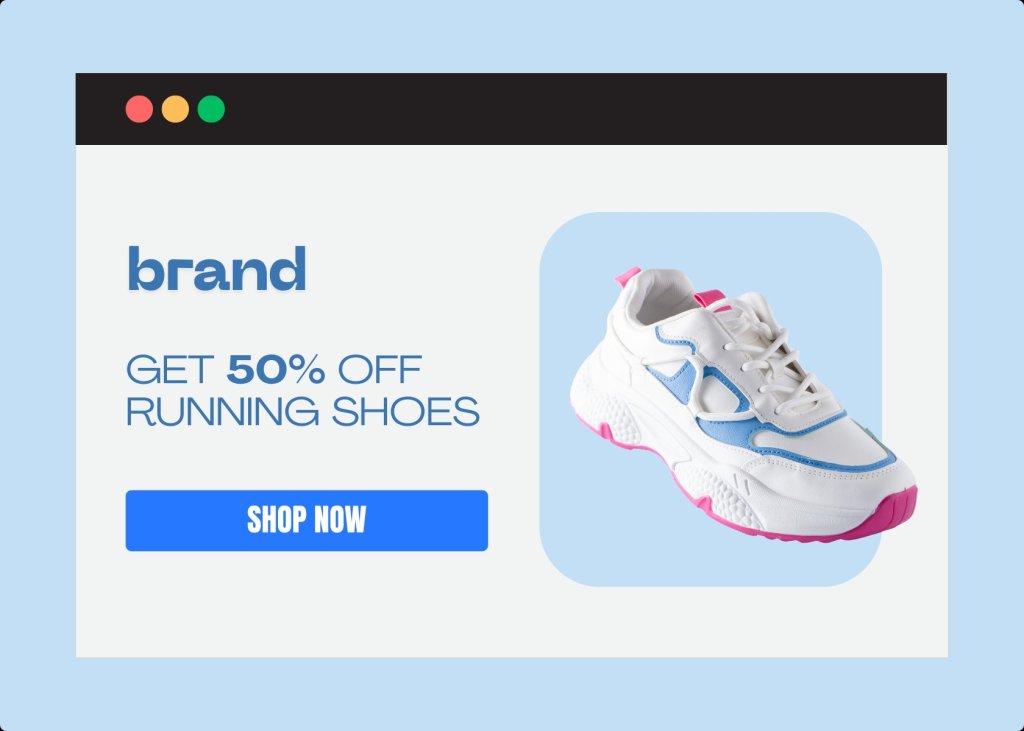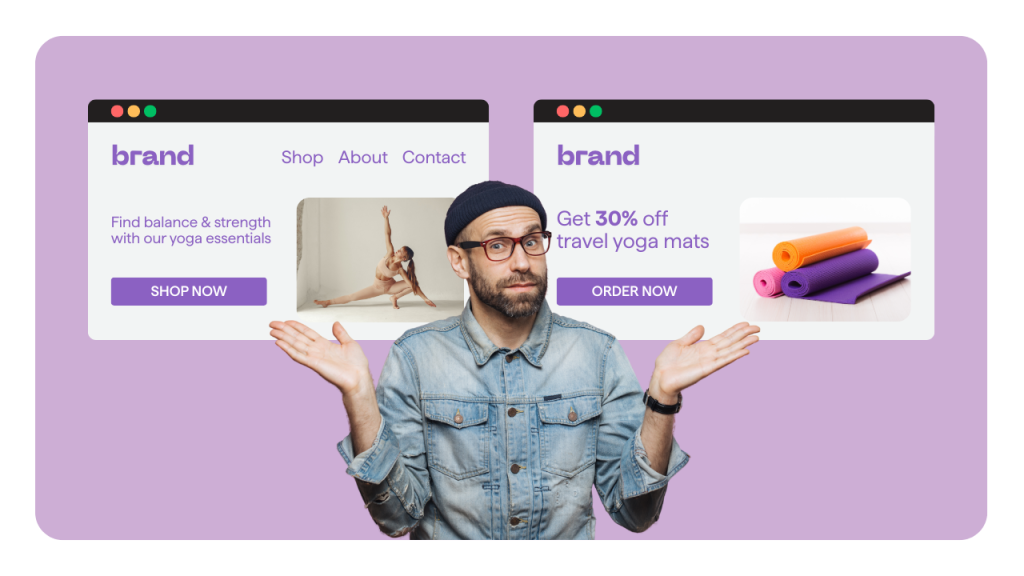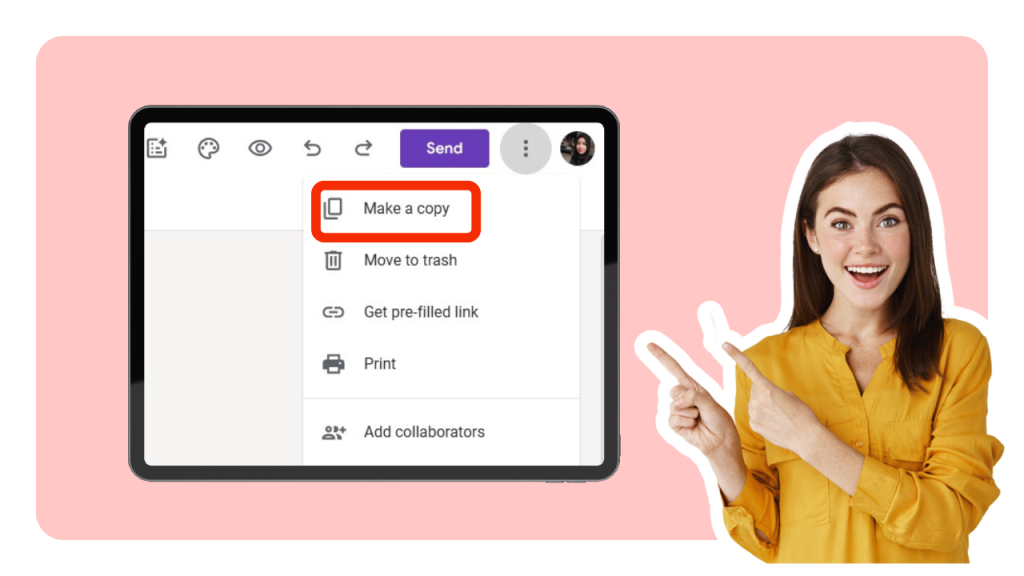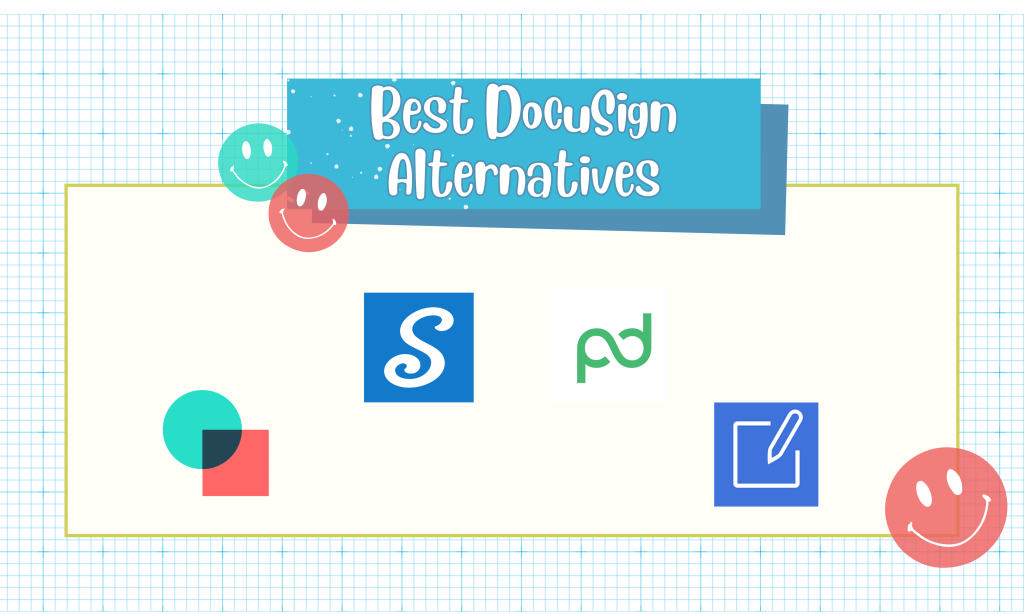Every online business uses web pages, but landing pages, homepages, and websites serve very different roles.
Each page type has its own strengths. Landing pages excel at converting visitors on specific campaigns, while homepages and full websites excel at informing visitors and building a brand presence. Using the right page in the right context can dramatically improve marketing results. Below we’ll define each, compare their key traits, and explain when to use each one.
What Is a Landing Page?
A landing page is a standalone page created with a specific, single goal in mind, such as capturing leads, generating sales, or encouraging signups. Unlike a homepage, it eliminates distractions and directs visitors toward one clear action.
The main purpose of a landing page is to focus attention on conversion, making it ideal for marketing campaigns, ads, or promotions. Every element is designed to support that single objective.
Key elements of a landing page include:
A compelling headline that grabs attention
Benefit-driven copy highlighting the offer
A single, clear CTA (e.g., “Sign Up Now” or “Download Free Guide”)
A form or purchase button to complete the action
For instance, a product launch page or an ebook download page is a typical landing page, guiding visitors to take one action without distractions.

What Is a Homepage?
A homepage is the main entry point of a website, often the first page visitors see when typing in your domain. It serves as a central hub that introduces your brand and guides users to different sections of your site.
The primary purpose of a homepage is navigation, branding, and providing an overview of what your business offers. Instead of pushing a single action, it gives visitors multiple pathways to explore, whether that’s learning about your products, reading your blog, or contacting your team.
Key elements of a homepage include:
A navigation menu for browsing different pages
Multiple CTAs (calls-to-action) for various actions
Company information and brand identity

What Is a Website?
A website is the full set of web pages that make up your online presence under one domain. This includes the homepage, about page, product/service pages, blog, contact page, FAQ, and any others.
Key characteristics of a website:
Unlike a single landing page, a website has multiple interconnected pages (often dozens or hundreds). Each page covers specific topics (e.g. product features, company history, blog posts).
A website provides comprehensive details about your business. It explains who you are, what you offer, and why it matters.
A website often includes trust elements like testimonials, reviews, and an “About Us” section to build credibility.
Websites can support many functions: an e-commerce site has shopping carts and checkout pages; a membership site has login portals; a blog site has article archives; a support site has forums or ticket systems. Essentially, a website can do anything from selling products to hosting a community.
Landing Page Vs Homepage: The Key Differences.
Feature | Homepage | Landing Page |
Purpose | Introduce the brand, showcase offerings, guide users to different sections | Drive a specific action (sign-up, purchase, or download) |
Audience | Broad visitors exploring your site | Targeted traffic from ads, emails, or campaigns |
CTAs (Calls-to-Action) | Multiple buttons and links for various purposes | One focused CTA aligned with the campaign goal |
Navigation | Full menu and site-wide navigation | Minimal or no navigation to prevent distraction |
SEO Role | Optimized for broad, branded keywords | Optimized for campaign-specific keywords or ads |
Conversion Rate | Lower (1–2%) due to multiple goals | Higher (5–25%) due to a single conversion path |
In short: a homepage is great for branding and exploration, but a landing page is designed for focus and conversion. If you’re running a campaign or ad, sending visitors to a landing page will nearly always deliver higher ROI and lead quality.
Landing Page Vs Website: The Key Differences
Feature | Website | Landing Page |
Scope | Multi-page platform (home, products, blog, contact, etc.) | Single, campaign-focused page |
Purpose | Build brand presence, educate visitors, support SEO | Convert visitors from a specific campaign |
Content Depth | In-depth information across many topics | Short, persuasive content for one offer |
Navigation | Full menus and internal links | No or minimal navigation for focus |
SEO Role | Targets multiple keywords and audiences | Targets one keyword or campaign offer |
Longevity | Permanent and continually updated | Temporary or campaign-specific |
Conversion Rate | Moderate (depends on intent) | Higher (focused on one conversion) |
In short: a website builds trust and authority over time, while a landing page delivers quick, measurable conversions. Use both strategically, your website to educate and nurture, and your landing pages to convert and capture leads fast.
Homepage Vs Website: The Key Differences
Feature | Homepage | Website |
Definition | The main entry point or “front door” of your site | The full collection of all pages under your domain |
Purpose | Introduce brand and direct traffic | Educate, sell, and engage across multiple topics |
Navigation Role | Hub for internal navigation | Includes all internal pages and navigation paths |
Content Depth | Overview of brand and key offerings | Detailed pages for every product, service, or resource |
Audience | First-time visitors and general users | All visitors at every stage of the customer journey |
SEO Role | Ranks for branded or top-level keywords | Ranks for a wide range of long-tail and informational keywords |
In short: your homepage is the gateway, while your website is the destination. The homepage welcomes and orients visitors; the website provides the full experience, helping users explore, learn, and take action.
When to Use a Homepage
Since a homepage is part of a website, the decision to use it is simple: always have one as the entry point to your site. However, optimizing your homepage matters. Use it to:
Introduce Your Brand: Use your homepage to deliver a clear elevator pitch. Highlight your mission, top offerings, and value proposition with concise messaging and strong visuals.
Guide Navigation: Structure it so visitors can easily find what they need. Include clear menus and links to main sections (products, services, contact, blog, etc.). Studies show 64% of users expect a phone number on a homepage, and 44% leave if they can’t find contact info, so make it visible and easy to reach you.
Act as a News Hub: Feature blog snippets, new releases, or current promotions. Link special offers to dedicated landing pages to track performance.
Support SEO: Since the homepage attracts most backlinks and organic traffic, optimize it for branded and high-level keywords. A clear structure helps search engines understand your business.
When to Use a Website
A full website (beyond just landing pages) is indispensable in these situations:
Build Brand Presence: Your website presents your full identity, history, team, and product lineup, acting as your virtual business card, portfolio, and storefront.
Run an E-commerce Store: Selling multiple products requires a website with categories, carts, and checkout. Even so, create landing pages for special promotions to drive conversions faster.
Content Marketing & SEO: Blogs and guides boost authority and organic reach. Each post can rank for relevant keywords and draw in new traffic consistently.
Host Communities or Courses: If you offer forums, memberships, or online education, a multi-page structure is essential. It allows you to organize profiles, lessons, and user areas effectively.
Company Info & Support: Pages for FAQs, careers, or customer support build credibility and help customers find answers easily.
When to Use Landing Pages
Landing pages are ideal whenever you have a specific marketing goal or promotion. Common use cases include:
Paid Ad Campaigns: Always link PPC or social ads to a dedicated landing page aligned with your ad message. This can boost ROI and improve ad Quality Scores.
Product Launches: Landing pages spotlight new products and features. Wix reports they help focus customer attention solely on one item, driving higher engagement.
Promotions & Sales: For limited-time offers or discounts, landing pages create urgency and clarity. They’re easy to update for recurring campaigns.
Lead Generation: According to involve.me, 43.6% of marketers use landing pages primarily to capture leads. Focus on one value offer, like a free ebook or trial, and keep forms short.
Events & Webinars: A clear, dedicated registration page can improve attendance. Nearly 60% of webinar sign-ups happen within a week of the event, so make the CTA clear and deadline-driven.
A/B Testing & Optimization: Landing pages make testing easy. Even small tweaks like a new headline or button color can lift conversions by 10–30%.
Create your own landing pages
Get started with 300+ templates
Why Landing Pages Convert the Most
Among all page types, landing pages generally have the highest conversion rates, and there are good reasons why:
Single Conversion Goal
A landing page has one primary objective. Think of it like a bucket with one hole: all the “water” (traffic) flows to that one spot. By comparison, a homepage or general page might have many “holes” (CTAs) and competing links. According to WordStream, focusing on one CTA can multiply results, email campaigns with a single CTA saw a 371% increase in clicks.. In practice, this means landing pages channel attention to exactly one action, leaving less chance for visitors to wander away.
Minimal Distractions
By design, landing pages remove anything that could dilute the message. Navigation bars, extra links, and irrelevant content are usually gone. This clutter-free layout “keeps the entire page centered on one message and one call to action,” which boosts the likelihood of immediate action. (In contrast, 70% of small-business homepages lack a clear CTA, a mistake that reduces conversions.)
Customized Experience
Landing pages can be perfectly tailored to the source of the traffic. The headline, copy, and images match the visitor’s expectations from the ad or email. This alignment preserves momentum and trust. For example, showing an ad for webinar signups and sending the click to a custom landing page about that webinar keeps people engaged. If instead you diverted them to a generic homepage, up to 56% of your paid clicks could end up not finding the offer they came for.
Audience Targeting
You can duplicate a landing page and tweak it for different segments. For instance, separate pages for men vs women products, or for different geographic markets, can speak directly to each group. This precise targeting dramatically improves relevance. In practice, many marketers A/B-test landing pages to see which version converts best. In one case study, creating highly personalized landing pages yielded a 68% conversion lift over generic pages.
Speed and SEO
Because landing pages are smaller, they tend to load faster, which users love. Nearly half of users expect a page to load within 2 seconds, and a one-second delay can cut conversions by ~7%. Faster load times on landing pages help keep visitors engaged. Also, landing pages with targeted keywords may get additional traffic from search if optimized, though their main role is for paid or direct campaigns.
Common Mistakes to Avoid When Using Landing Pages, Homepages, and Websites
Even with great design and clear goals, many marketers and businesses lose potential conversions by misusing these page types. Avoiding the following mistakes can save you wasted ad spend, improve engagement, and boost ROI.
1. Sending Ad Traffic to the Homepage
One of the biggest mistakes is directing paid traffic to your homepage instead of a dedicated landing page. A homepage serves too many purposes, visitors can easily get distracted, explore other sections, or leave without converting.
Fix: Always send ad or email traffic to a landing page that matches the ad’s message and has one clear CTA. Studies show landing pages can achieve up to 10× higher conversions than generic homepages when aligned with campaign intent.
2. Mixing Multiple CTAs on a Single Page
Adding too many buttons (“Learn More,” “Buy Now,” “Subscribe,” “Contact Us”) on one page overwhelms visitors and divides attention.
Fix: Keep one primary CTA per page. On a homepage, you can use multiple CTAs but ensure each is hierarchically prioritized, the main goal should stand out visually. On landing pages, stick to a single, focused CTA.
3. Ignoring Mobile Optimization
Over 58% of global web traffic now comes from mobile devices, yet many brands still design primarily for desktop. Pages that aren’t responsive cause users to bounce quickly, especially if forms are hard to fill or buttons are too small.
Fix: Adopt a mobile-first design approach. Test your landing pages, homepages, and website layouts on different devices and screen sizes. Use tools like Google’s Mobile-Friendly Test to ensure fast, responsive design.
4. Neglecting Page Speed
Even a one-second delay in load time can cause a 7% drop in conversions. Heavy visuals, videos, or scripts can slow down pages, particularly landing pages that should feel instant.
Fix: Compress images, use a CDN, and test speed regularly with tools like PageSpeed Insights or GTmetrix. Every second counts.
5. Forgetting SEO on the Website
While not every landing page needs SEO, your website as a whole must be optimized. Many businesses focus entirely on ad campaigns but ignore organic visibility.
Fix: Ensure your website (and homepage) have proper meta tags, internal links, and keyword-optimized content. This builds long-term authority and free traffic that complements your paid efforts.
6. Overloading with Content or Visuals
Cluttered pages overwhelm visitors. Too much text, competing colors, or large blocks of information can confuse users and bury your CTA.
Fix: Embrace visual hierarchy and whitespace. Each element, headline, image, CTA should lead the visitor naturally toward the next step. On landing pages, keep the layout minimal and distraction free.
7. Failing to Track Performance
Launching pages without tracking conversions is like flying blind. Many marketers forget to connect analytics or set goals properly.
Fix: Use tools like Google Analytics, Tag Manager, or built-in analytics from platforms like involve.me to monitor conversions, scroll depth, and engagement. Test, learn, and optimize continuously.
Final Words
Landing pages, homepages, and websites each have distinct roles in your marketing toolkit. Landing pages are the tactical pages you deploy for campaigns and promotions, they isolate one offer and guide visitors to act. Homepages are your brand’s welcome mat, giving a broad introduction and paths to explore. And the website is the full foundation, where your entire brand story, products, and content live.
You can greatly improve your marketing results by using these page types correctly. Direct your paid ads to dedicated landing pages for the best conversion lift, while maintaining a strong homepage and website for discovery, branding, and customer support.
Ready to put these principles into practice? Consider using a landing page builder like involve.me, which offers drag-and-drop templates and integrations to help you quickly create focused, high-converting pages.
Create a landing page in minutes, for free
No coding, no hassle, just better conversions.







